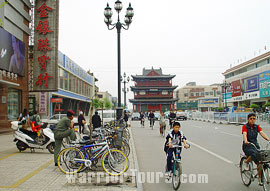Datong Introduction
 Datong is one of the city famous for it's history and culture and is located at the northern part of Shanxi Province. It is 380 km (236 miles) west of Beijing and 352 km (219 miles) north of Taiyuan, and is an important traffic junction with great strategic importance. Consisting of four districts and seven counties, Datong covers an area of 14,152 sq km (3,497,032 acres) and has a population of over 3 million. Mt. Hengshan, Mt. Cailiang, Mt. Mafu and many other mountains and hills surround the city combines with more than 20 rivers running through the region make it a wonderful place with beautiful natural scenery. There are also abundant mineral resource of which the coal mine is the most famous which gives Datong the title Capital of Coal.
Datong is one of the city famous for it's history and culture and is located at the northern part of Shanxi Province. It is 380 km (236 miles) west of Beijing and 352 km (219 miles) north of Taiyuan, and is an important traffic junction with great strategic importance. Consisting of four districts and seven counties, Datong covers an area of 14,152 sq km (3,497,032 acres) and has a population of over 3 million. Mt. Hengshan, Mt. Cailiang, Mt. Mafu and many other mountains and hills surround the city combines with more than 20 rivers running through the region make it a wonderful place with beautiful natural scenery. There are also abundant mineral resource of which the coal mine is the most famous which gives Datong the title Capital of Coal.

![]() Things to Do
Things to Do
Due to the long and splendid history, a lot of cultural and historical relics were left in Datong. There are seven grottoes, 196 ancient architectures, 37 ancient ruins, 25 old tombs and 12 ancient steles according to the existing records and research. Among these, Yungang Caves, Huayan Temple, Nine-dragon Screen, Hanging Monastery and Wooden Pagoda are most famous. As one of the Three Great Caves (the other two are Mogao Caves and Longmen Caves) in China, Yungang Grottoes was firstly constructed during the fifth century, comprising of more than five million vivid stone statues. The Hukou Waterfalls also is a strong recommendation.
The grand Daxiongbaodian Hall in Huayan Temple covers an area of 1,559 sq meters (about 0.39 acres), which made it the largest existing Buddhist hall in Liao and Jin dynasties. All the architectures, statues, murals, ceilings, etc are well preserved and embody a magnificent Liao style. Nine-dragon Screen in Datong is three times as large and 350 years older than the one in Beihai Park, Beijing.
![]() History
History
Datong is a city with a long history. As early as Palaeolithic age, there were ancient people living in this area. During the Warring States Period (476 BC - 221 BC), the region belonged to the Yanmen County of Zhao Kingdom. After Qin (221BC - 206 BC) unified the whole country, the Great Wall was built west of Datong City. Datong got the name Pingcheng County that means peaceful city in Chinese because of years of harsh battle with the Hun. During the Northern and Southern Dynasties (420 - 589), Pingcheng was settled as the capital of Northern Wei Kingdom for 96 years and became ruins at the year 526. After a long term of recovering, it became an important strategic county during Sui (581 - 618), Tang (618 - 907) and Five Dynasties (907 - 979). Liao Dynasty (916 - 1125) made Datong the auxiliary capital in 1044 and Jin (Kin) (1115 - 1234) retained it as a big city comprised of seven counties and three towns. During the Yuan Dynasty (1271 - 1368), it belonged to Zhongshu Province and had become a 'grandiose and beautiful city' according to the description of the Italian traveler Marco Polo. In Qing Dynasty (1644 - 1911), it belonged to Shanxi Province and became Datong County during the domination of Republic of China. Datong was invaded by Japanese army in 1937 and became the capital of the so-called Northern Shanxi Self-Government. Finally in 1949, Datong was peacefully liberated.
![]() Weather
Weather
The area enjoys the continental monsoon climate, winter is extremely cold and dry, and spring and fall are cool but the temperature varies sharply between day and night. The average annual temperature is 5.5 °C (41.9 °F), and the highest temperature is 37.7 °C (99.86 °F) while the lowest -29.1 °C(-20.38 °F). During the summer the city is a natural tourist resort because the average temperature is only 19~21 °C (66.2~69.8 °F). The best time to visit Datong is during July and August.
![]() Transportation
Transportation
Datong airport started operation in May 2005, and airlines to Shanghai, Beijing, Guangzhou and many other big cities are available. Daily trains to Taiyuan, Beijing, Hangzhou, Baotou, Shenyang, etc also run smoothly in Datong Railway Station and four long-distance coach stations are useful and convenient. For getting around the city, buses and taxis are cheap and flexible to choose.
![]() Dining & Local Products
Dining & Local Products

